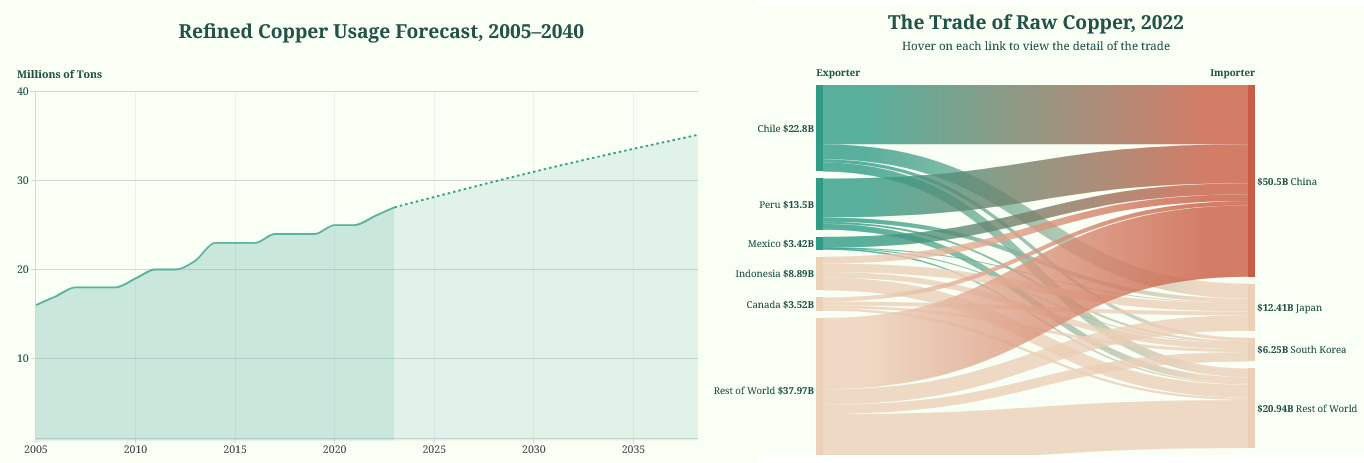Home
| About
| Mine Tracker
| RSS
| Footer
▄▄▄▄▄▄▄▄▄▄▄▄▄▄▄▄▄▄▄▄▄▄▄▄▄▄▄▄▄▄▄▄▄▄▄▄▄▄▄▄▄▄▄▄▄▄▄▄▄▄▄▄▄▄▄▄▄▄▄▄▄▄▄▄▄▄▄▄▄▄▄▄▄▄▄▄▄▄▄▄▄▄▄▄▄▄▄▄▄▄▄▄▄▄▄▄ █▄▄░▄▄█░▄▄▀█░▄▄▀█▀▄▀█░▄▄███░▄▄▀█░▄▄▀█░▄▀███▄▄░▄▄█░▄▄▀█░▄▄▀█▀▄▀█░▄▄█░▄▄▀█░▄▄▀██▄██░███▄██▄░▄█░██░ ███░███░▀▀▄█░▀▀░█░█▀█░▄▄███░▀▀░█░██░█░█░█████░███░▀▀▄█░▀▀░█░█▀█░▄▄█░▀▀░█░▄▄▀██░▄█░███░▄██░██░▀▀░ ███░███▄█▄▄█▄██▄██▄██▄▄▄███▄██▄█▄██▄█▄▄██████░███▄█▄▄█▄██▄██▄██▄▄▄█▄██▄█▄▄▄▄█▄▄▄█▄▄█▄▄▄██▄██▀▀▀▄ ▀▀▀▀▀▀▀▀▀▀▀▀▀▀▀▀▀▀▀▀▀▀▀▀▀▀▀▀▀▀▀▀▀▀▀▀▀▀▀▀▀▀▀▀▀▀▀▀▀▀▀▀▀▀▀▀▀▀▀▀▀▀▀▀▀▀▀▀▀▀▀▀▀▀▀▀▀▀▀▀▀▀▀▀▀▀▀▀▀▀▀▀▀▀▀▀
Latin America: The World’s Copper Stronghold
https://features.csis.org/copper-in-latin-america/

?By 2030, the International Energy Agency predicts that the total copper production from existing mines and mines under construction will only meet 80 percent of the world’s copper needs.
https://features.csis.org/copper-in-latin-america/

?By 2030, the International Energy Agency predicts that the total copper production from existing mines and mines under construction will only meet 80 percent of the world’s copper needs.
Report; Forced evictions at industrial cobalt and copper mines in the Democratic Republic of the Con
https://www.amnesty.nl/content/uploads/2023/09/EMBARGOED_EN-version-Powering-Change-or-Business-as-Usual.pdf

This trend is driving the demand for other raw materials. Electric vehicles and energy storage facilities require vast and increasing amounts of mined metals, including copper and cobalt. According to the International Energy Agency, copper is the most widely used mineral in clean energy technologies, while cobalt is an essential mineral for most lithium-ion batteries. Expectations of accelerating demand for these two minerals are behind the increase in industrial mining in and around the city of Kolwezi, in the southern province of Lualaba in the Democratic Republic of the Congo (DRC), where many of the country’s most productive cobalt and copper mines are located. The DRC holds the seventh largest reserves of copper globally and is the third largest producer. It also holds approximately half of the world’s cobalt reserves and accounts for more than 70% of global production. The people living in the region should be benefiting from the growth in mining. Instead, many are being forced out of their homes and farmland to make way for the expansion of large-scale industrial mining projects. As this report shows, such evictions are often carried out by mining operators with little concern for the rights of affected communities and little heed for national laws meant to curtail forced evictions in the mining sector.
https://www.amnesty.nl/content/uploads/2023/09/EMBARGOED_EN-version-Powering-Change-or-Business-as-Usual.pdf

This trend is driving the demand for other raw materials. Electric vehicles and energy storage facilities require vast and increasing amounts of mined metals, including copper and cobalt. According to the International Energy Agency, copper is the most widely used mineral in clean energy technologies, while cobalt is an essential mineral for most lithium-ion batteries. Expectations of accelerating demand for these two minerals are behind the increase in industrial mining in and around the city of Kolwezi, in the southern province of Lualaba in the Democratic Republic of the Congo (DRC), where many of the country’s most productive cobalt and copper mines are located. The DRC holds the seventh largest reserves of copper globally and is the third largest producer. It also holds approximately half of the world’s cobalt reserves and accounts for more than 70% of global production. The people living in the region should be benefiting from the growth in mining. Instead, many are being forced out of their homes and farmland to make way for the expansion of large-scale industrial mining projects. As this report shows, such evictions are often carried out by mining operators with little concern for the rights of affected communities and little heed for national laws meant to curtail forced evictions in the mining sector.
‘Born with a copper spoon’ shows Africa’s long struggle for resource control
https://www.theafricareport.com/272858/born-with-a-copper-spoon-shows-africas-long-struggle-for-resource-control/
Former Zambian President Kenneth Kaunda once said that his countrymen were “born with a copper spoon in our mouths.” A new book traces Africa’s key role in copper’s global history and its struggle to get fair value for its resources.
https://www.theafricareport.com/272858/born-with-a-copper-spoon-shows-africas-long-struggle-for-resource-control/
Former Zambian President Kenneth Kaunda once said that his countrymen were “born with a copper spoon in our mouths.” A new book traces Africa’s key role in copper’s global history and its struggle to get fair value for its resources.
Article, Droughts and Dams
https://www.phenomenalworld.org/analysis/droughts-and-dams/
Most of Zambia’s grid electricity is generated by hydropower. Over the past decade, recurring droughts—in 2015, 2016, 2019, and now again in 2022—have exposed deep vulnerabilities in the system. These droughts have unleashed unprecedented power outages, with low reservoir levels constraining hydroelectricity generation capacity.
https://www.phenomenalworld.org/analysis/droughts-and-dams/
Most of Zambia’s grid electricity is generated by hydropower. Over the past decade, recurring droughts—in 2015, 2016, 2019, and now again in 2022—have exposed deep vulnerabilities in the system. These droughts have unleashed unprecedented power outages, with low reservoir levels constraining hydroelectricity generation capacity.
Copper Alliance - copper pathways
https://copperalliance.org/sustainable-copper/copper-pathways-map/
A global view of copper production and trade
https://copperalliance.org/sustainable-copper/copper-pathways-map/
A global view of copper production and trade
Coppermark certification status dashboard
https://coppermark.org/participants-home/participants/
Copper mark certified sites and status
https://coppermark.org/participants-home/participants/
Copper mark certified sites and status